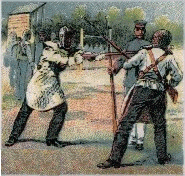
BAYONETS FOR HECKLER & KOCH ASSAULT RIFLES
by R.D.C. Evans
The German armaments firm of Heckler & Koch were responsible for one of the most successful series of assault rifles to be produced during the post Second World War years. Their rifles have been sold to well over 30 nations world-wide, as well as being employed by the German (formerly West German) military. In some ways, modern assault rifle bayonets are particularly difficult to study as compared to the weapons of earlier eras. The standardisation of muzzle (or flash-hider) dimensions for the rifles of allied groups of nations, such as members of NATO, has been necessitated by the desire to achieve interchageability of rifle grenades amongst the armies of friendly powers. This means that whole groups of modern assault rifle bayonets share the same muzzle ring diameter. A consequence of this has been the development of bayonet adaptors which allow bayonets designed for one type of assault rifle to be readily fixed on a wide variety of other contemporary military firearms. The German Eickhorn company has been particularly active in developing bayonet adaptors of this kind. Such interchangeability can make bayonet identification doubly difficult for today’s collectors as it can make it hard to assign a particular bayonet to a particular nation or to match it with a particular companion firearm. Having said this, bayonets for Heckler & Koch assault rifles nevertheless remain a relatively distinctive group, easy to recognise and perhaps an ideal subject for a specialised collector. A rather bewildering variety of bayonets have been developed for use with H&K rifles during the last 50 years or so. Most of these have been illustrated and described in books or magazine articles, and the majority of bayonet collectors will have some general idea of the types of bayonet employed. In many ways the bayonets are a particularly interesting group – the method of fixing on the rifle is for example extremely unusual. As far as is known, no serious attempt has yet been made to study, classify and identify these bayonets for the benefit of collectors and other students of the subject. It is hoped that the information presented here in PDF format will serve as a useful introductory guide to a fascinating group of bayonets. It is by no means the definitive treatment of these weapons as there is scope for much further research, but it is hoped that it will stimulate interest among collectors and encourage future investigations.
